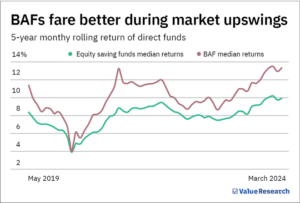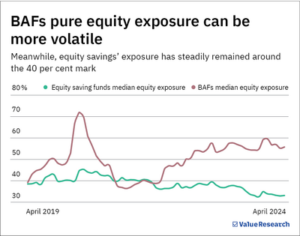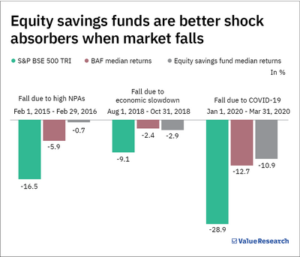Equity-debt asset allocation mandate
Although both invest in equity and debt, balanced advantage funds (also known as dynamic asset allocation funds) are more flexible. They don’t have any restrictions on how much equity, debt or arbitrage they can opt for. On the other hand, equity saving funds must have at least 65 per cent of investor money in equities/equity-related (including arbitrage) and 10 per cent in debt.
Pure equity exposure
Balanced advantage funds (BAFs) usually have a higher and more volatile exposure to pure equity, as can be seen in the graph below.
Over the last five years, the category median (read average) exposure to un-hedged equity has swayed between 37 and 72 per cent. On the other hand, it has mostly remained around 40 per cent for equity savings funds.
Performance during good times
As BAFs tend to have a slightly bigger appetite for equities compared to equity savings funds, they usually outperform the latter when the market is climbing.

- Performance during low phases
The debt and arbitrage portions in BAFs and equity saving funds help reduce volatility compared to pure equity funds. So, while they may still experience downside during extreme market conditions, the debt and arbitrage components cushion their fall from being as severe as the broader market indices, as seen in the graph below. And when you directly compare BAFs and equity savings funds, the latter does slightly better. That’s because they are comparatively more conservative in nature.
Tax
Equity saving funds and BAFs enjoy the same taxation benefits as equity funds, where long-term capital gains of investments over one year are taxed at just 10 per cent, while short-term gains (investments less than a year old) are taxed at 15 per cent. However, bear in mind that if BAFs maintain an exposure of less than 65 per cent in equity and arbitrage, they are taxed differently. That said, it’s very rare for BAFs to have a gross equity exposure of less than 65 per cent.
Disclaimer: – Mutual funds investments are subject to market risk. Please read the offer documents carefully before investing


